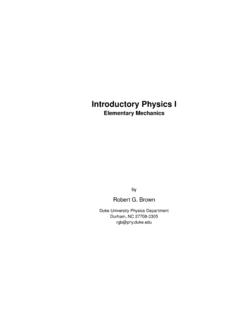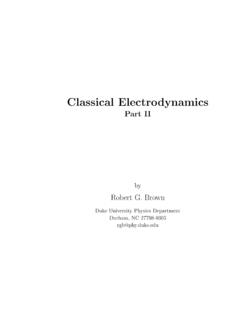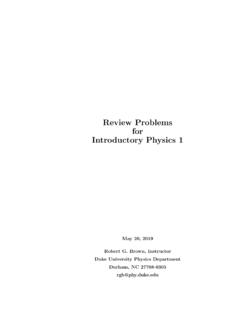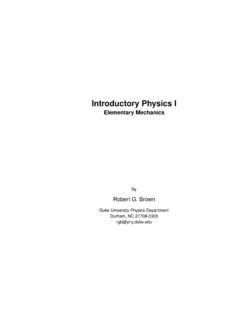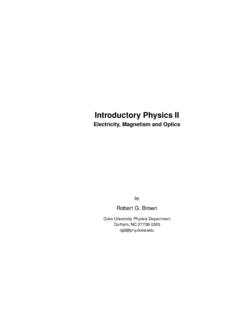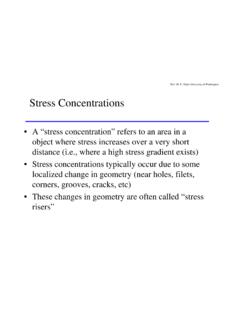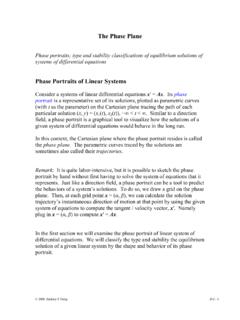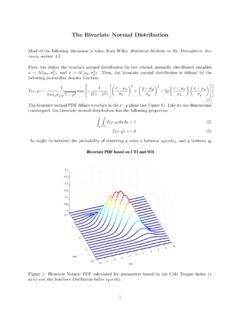Transcription of Satellite Motion - Duke University
1 Physics 53 Satellite Motion You know, it's at times likes this when I'm stuck in a Vogon airlock with a man from Betelgeuse, about to die from asphyxiation in deep space, that I wish I had listened to what my mother told me when I was young. Why, what did she say? I don't know. I didn't listen. Hitchhiker's Guide to the GalaxyRadial and angular motionWe will be concerned here with the orbiting Motion of a Satellite , such as a planet around the sun, or the moon around the earth. We neglect the effects of all other will assume that the Satellite 's mass (m) is much smaller than that (M) of the body it moves around. Both bodies actually orbit around the CM of the system, but M moves only a small amount because the CM is so close to it. We ignore this Motion as an approximation, and take the center of M to be the origin of our coordinate a system with two masses of comparable size, such as a double star, obviously this is a bad approximation and one must analyze the Motion of both bodies around the gravity (a central and conservative force) is the only force doing work:The total mechanical energy E of the system is gravitational force acts along the line between the two bodies, so there is no torque about the origin.
2 This means that:The total angular momentum L of the system about the origin is is still true if the CM is taken as origin even when we take account of the Motion of both will find that the nature of the trajectory is determined by the values of these two conserved velocity of the Satellite has in general two components, one parallel and one perpendicular to the position vector r of the Satellite . We call these the radial and tangential velocities and write v=vr+v .The kinetic energy then breaks into two parts:PHY 53 1 Satellite Motion K=12mvr2+12mv magnitude of the angular momentum of the Satellite is given by L=mrv so we can solve for v in terms of L and write the kinetic energy as: K=12mvr2+L22mr2. Now we add the potential energy to get the total energy: E=12mvr2+L22mr2 expression is essentially one-dimensional, since the only variables in it are the speed along the radial line between the two bodies and their distance apart along that line.
3 The second term in the formula is actually the tangential part of the kinetic energy, but since L is constant we have been able to express it a function only of the distance the energy is formally one-dimensional, we can use the methods given earlier (see Energy 2) to determine turning points in the radial Motion . This will give us the distances of closest approach and furthest recession of the Satellite is not actually at rest at these turning points. Its velocity component parallel to r is zero, but it will still have a velocity component perpendicular to define an effective potential energy by combining the terms that depend only on r: Ueff(r)=L22mr2 GMmr,so that E=12mvr2+ points where the total energy E is equal to Ueff the kinetic energy of radial Motion along the line between the bodies is (instantaneously) zero.
4 Those are the turning points in the radial see that as r , Ueff 0. This means that if the total energy E is positive (or zero) there is no turning point for large values of r, hence the Motion is unbound. But if E is negative there are two turning points and we have bound 53 2 Satellite MotionTypes of orbitsShown is a typical curve for Ueff, with three different possible values of the total energy positive energy E1 there is only one turning point, at r0. If the system has this energy, m approaches M to distance r0 and then moves away, never to return. The Motion is unbound; the trajectory can be shown to be a hyperbola passing around M. Comets that appear only once in our solar system are of this negative energy E2 there are turning points at both r1 and r2. The distance between m and M varies back and forth between these values.
5 The Motion is bound, and the trajectory can be shown to be an ellipse with M at one focus. (Kepler s 1st law.)For negative energy E3 the two turning points coincide and the ellipse becomes a circle of radius is a simple rule about the nature of the trajectories:Positive (or zero) total energy gives unbound Motion , while negative total energy gives bound dichotomy between positive and negative total energy arises from our having chosen potential energy to be zero when the objects are infinitely far apart, so at finite distances it is negative. Ueff E1 E2 E3 r r2 r3 r1 r0 PHY 53 3 Satellite MotionElliptical orbitsShown is a typical elliptical turning points rp and ra are the distances of closest approach and furthest recession. These points are usually denoted by the Greek prefixes peri ( around ) and apo ( from ).
6 Thus a planet s point of closest approach to the sun is called its perihelion, and its point of furthest recession is its aphelion (helios is sun in Greek).For satellites around the earth, the corresponding names are perigee and apogee. We find the turning points by setting Ueff=E, remembering that E is negative. L22mr2 GMmr=E, or r2+G mEr L22mE=0 The roots of this equation are rp and ra, so it must be the same as (r rp)(r ra)=0, orr2 (rp+ra)r+rpra=0 Comparing the coefficients in these different two forms, we see that rp+ra= GMmE,rpra= L22mEThe turning points are related to the axes of the ellipse by rp+ra=2a, rpra=b2,so we can write the energy and angular momentum of the orbit in terms of a and b: elliptical orbit relationsEnergy: E= GMm2aAngular momentum: L2= 2mEb2 The first of these is an important formula, showing that the energy depends only on the length of the orbit 2a.
7 The second shows that L is proportional to b, so more eccentric orbits (smaller b) correspond to lower L. Maximum L occurs for a circular orbit, b=a. r a b ra rpPHY 53 4 Satellite MotionKepler's lawsIn our analysis we did not prove that the orbits are ellipses (Kepler's 1st law), but it can be shown. We will now prove the other two of the 1st law requires an extensive use of calculus, so we will not give it is an elliptical orbit and the position of the Satellite at two times differing by dt. The Satellite moves a distance ds along the orbit, while the line connecting the bodies turns through angle d .The area swept out by the line is that of the narrow triangle dA=12rds. Since ds=rd we have dA=12r2d . The rate at which area is swept out is dAdt=12r2d dt=12r2 But r =v and mr2 =L, so we find dAdt=L2mSince L is a constant, we have shown that the rate at which area is swept out is constant.
8 This is Kepler's 2nd law, which we see is a simple consequence of conservation of angular we integrate this rate over the time for a complete revolution (the period T) we obtain the total area of the ellipse. Thus Area=LT2mThe area of an ellipse is ab. Substituting from the formulas given above relating E and L to a and b, we find after some algebra:Kepler s 3rd law a3T2=GM4 2 This shows that the ratio a3/T2 is the same for all objects orbiting a given mass M. This is Kepler's 3rd law. r d dsPHY 53 5 Satellite MotionBy measuring a and T one can use this relation to determine the mass M. It is in this way that we determine relatively easily the mass of the sun and the masses of those planets (such as earth) having , if we had taken into account the neglected Motion of M around the CM of the system, what would appear in the above formula would be the total mass M + m instead of M.
9 It is this quantity that one determines experimentally by measuring T and a. To determine M and m separately with high accuracy one must make detailed observations of the Motion of both bodies around the CM of the one knows m, then determination of M is easier. We now know the masses of Mercury and Venus (which have no moons) with high accuracy because we have been able to place satellites of known mass in orbit around them, and measure the orbit 53 6 Satellite Motio
